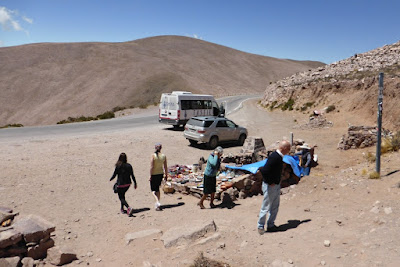Highway 52 took us west. Our first stop was for birding at a likely looking spot; Carlos was eager for us to see a giant hummingbird.
At first we were merely pulled over on the side of the road.
From here we could look down into a small valley on the right, barely visible in the photo above (click on the image to enlarge). Also in the photo's left are switchbacks with cargo traffic.
 |
| Joan and Carlos peer down into the wash. |
On the other side of the highway, a weathered corral.
Carlos took his Toyota down a dirt road into the wash. Perhaps he'd been here before, or perhaps he'd spotted foliage that hummingbirds favor, but while there we spotted our giant hummingbird.
Another brown-backed mockingbird, to bookend the one we saw yesterday.
We also saw the glittering-bellied emerald hummingbird, and the sparkling violetear hummer! These were flitting about too fast for me to grab a photo, but in the binoculars they were spectacular.
We had a long way to go and it was time to shove off. Ahead loomed the long, switchback climb to the next pass.
 |
| Those light-colored terraces are our route! |
On the narrow road you have to respect the truck traffic.
 |
| Think twice before trying to pass one. |
We paused while another group alternated taking pictures at the marker. Finally, Joan and the piggies had their turn, catching their breath at 4170 meters / 13,680 ft.
Joan and I gave the souvenir table a cursory glance; we're not in acquisition mode these days.
Minutes after we left the pass our first vicuña posed near the road.
 |
| What a delicate physique! |
 |
| It's amazing they can sustain themselves in this landscape. |
our stomachs were reminding us that lunch had been delayed. Carlos pulled into the last opportunity to grab a bite before entering the salar, despite not being familiar with the establishment.
It turned out to be a great place. The food was excellent, homemade and fresh, and the tables in the shade were comfortable. The owner had recently installed modern restrooms, very welcome even if the water pressure was feeble.
Many groups had stopped here; unknown to us, this is a popular motorcycle touring route. Many visitors had created a custom decal honoring their trip and these blanketed the windows of the restaurant.
 |
| Those blocks are made of salt. |
Salt sculptures rose here, including this llama.
The salt on the surface is dirty from windblown dust and detritus, but evaporation ponds
turn the brine into tidy white granules.
In the last few years a plant has also been operating at this salar to concentrate the brine made available by the salt drilling, which is then processed to generate lithium carbonate, a precursor for lithium-ion batteries.
The next stretch of time was spent driving; we were not quite halfway to San Pedro. At one town we stopped for some brief birdwatching, including Andean geese,
and replenishing our gasoline before entering Chile.
 |
| These poles are also plastered with tour decals. |
Fourth, there was vehicle and luggage inspection. Chile is very stringent about avoiding the importation of pests or invasive species, through agricultural products or otherwise, from the other side of the Andes. No animals are allowed, but fortunately the inspectors grinned when they saw our pigs. I had some chocolate-covered coffee beans in a baggie, which had to be explained. Joan was quicker on the draw than I was, and described them as "chocolate candies," thus avoiding any mention of coffee beans.
Just before or after entering Chile we saw our first flamingoes (there are several species in the Andes.) Click on the image to enlarge.
Our route wiggled, ascending and descending between 14,000 and 15,000 feet through a lunar landscape. When the line of volcanos including Licancabur came into view, Carlos knew we were getting close to our destination. The volcanos straddle the border between Chile and Bolivia.
 |
| The summit is 5916 meters or 19,409 feet. |
It was dinner time. We three couldn't quickly find the restaurant Carlos had in mind, based on second-hand directions, and chose one close to the hotel. It was somewhat noisy and tourist-y, but the food was OK and we were tired enough to be fine with it. Joan and I collapsed into bed.



















No comments:
Post a Comment
Comments may not appear immediately as they are moderated by the author to eliminate spam. Please, no commercial links!